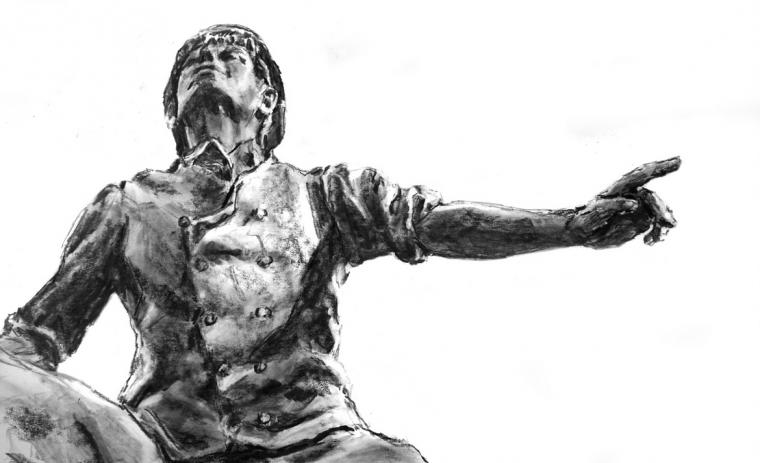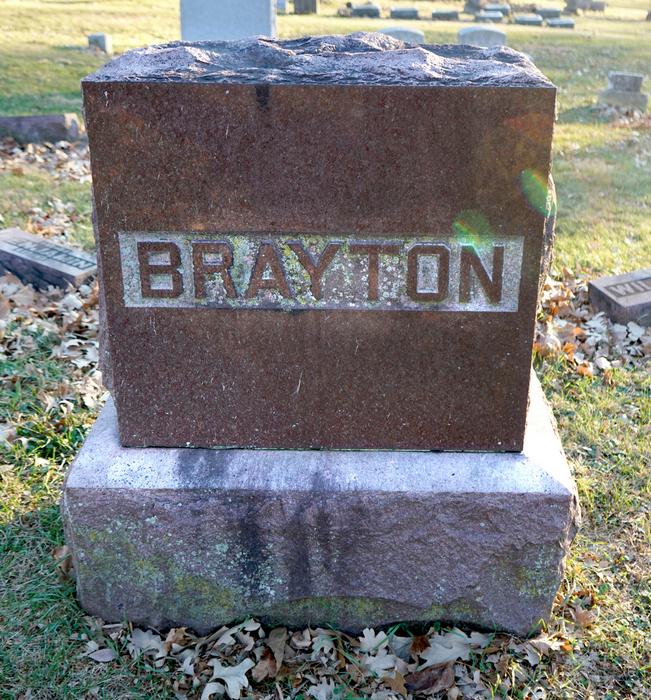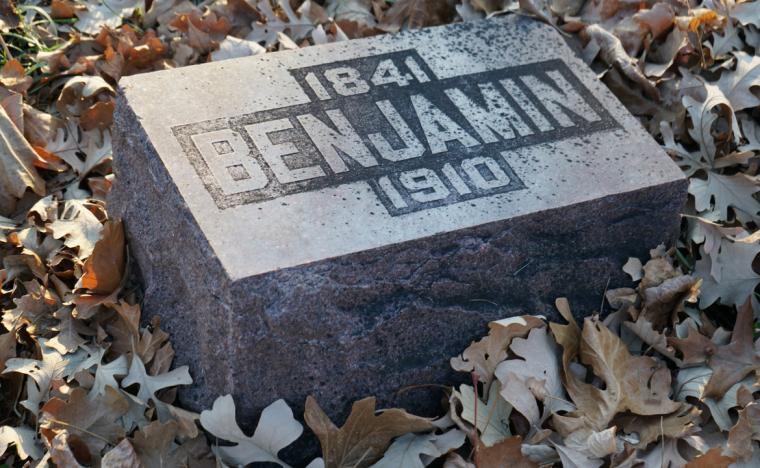
Benjamin Brayton drawing by Bruce Walters
A life-size bronze sculpture, Lincoln with Boy on Bridge, stands in downtown Davenport’s Bechtel Park near the Arsenal Bridge. Abraham Lincoln stands on a railroad track gazing forward; a seated boy looks up to him. Jeff Adams’ sculpture depicts a small moment between events that brought America closer to Civil War.
The 15-year-old boy was Benjamin “Ben” Brayton. Years later, he recalled that Lincoln arrived at the bridge with several men from a Chicago train. One of the men was his father, the bridge’s chief engineer. After a discussion, Lincoln left the group and approached Brayton seated on the bridge to ask, “Young man, are you employed here on this bridge? If so, will you go with me to the head of the draw pier and answer some questions?”
After answering Lincoln’s questions, Lincoln “thanked me, and said good night, joined his party, and stepped onto the special car in waiting, and was taken to Rock Island to await the night train for Chicago.”
Lincoln’s visit to the Quad-Cities came during his preparation of an 1857 trial: Hurd v. Rock Island Bridge Company. Only days after the completion of the first railroad bridge that spanned the Mississippi River, it was stuck of a steamboat, the Effie Aton. The boat’s owner, Captain John Hurd, filed suit in the U.S. District Court at Chicago, demanding damages from the Railroad Bridge Company for the total loss of his ship and cargo. Interestingly, one of the evacuated passengers was a young Samuel Clemens. Yes. Mark Twain.

A Supreme Court justice, John McLean, would preside over the trial. The Railroad Bridge Company selected Abraham Lincoln as lead counsel for the defense.
During the trial, Lincoln put the case into a much wider context when he pointed out that there was a need for "travel from East to West, whose demands are not less important than that of the river." For the first time, Lincoln was brought to the nation’s attention.
Benjamin Bucklin Brayton served as a key witness for the defense. Though his son was memorialized by the sculpture, the father had a far more significant role in the events and trial. He had located, designed, and supervised the bridge’s construction. When his testimony began, a Missouri newspaper’s headline read, “The Bridge Itself on the Stand.”
The 14-day trial ended was in a hung jury on September 8, 1857. Yet the 9-3 jury vote against Hurd was, effectively, a victory for Chicago and the railroads, a victory for the northern states. It was also instrumental in creating the first transcontinental railroad.
Jefferson Davis, then Secretary of War, had tried to stop the bridge’s construction as he understood that the railroad would bypass the South. Lincoln and Davis would again oppose each other in three-and-a-half years – this time as the presidents and commanders-in-chief of the Union and Confederate states.

Benjamin Brayton died the of typhoid fever in 1865, the same year of Lincoln's assassination. Both men were in their 50s when they died. Prior to serving as the Rock Island Bridge’s chief engineer, Benjamin was an assistant engineer on the Erie Canal. Afterward, he supervised the construction of the Rock Island Railroad that connected Davenport and Muscatine. He laid out and platted the city of Durant, Iowa.
Ben followed in his father's footsteps as a civil engineer. He died April 15, 1910, when struck by a motorcycle at the corner of Fifth Street and Bridge.
Both men are buried in Oakdale Memorial Gardens. A granite stone with the family name is near their individual gravestones that read simply “Father” and “Benjamin 1841-1910” (section 1, plot 68).
Bruce Walters is a Professor Emeritus in Art conferred by Western Illinois University.
This is part of an occasional series on famous (or infamous) people buried in cemeteries in the Quad Cities, and their history that is not so well-known today. If there’s a piece of history buried here that you’d like to learn more about, e-mail the location and a brief description to BD-Walters@wiu.edu.










